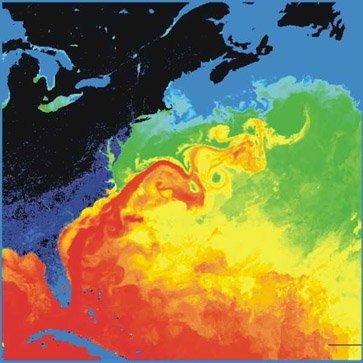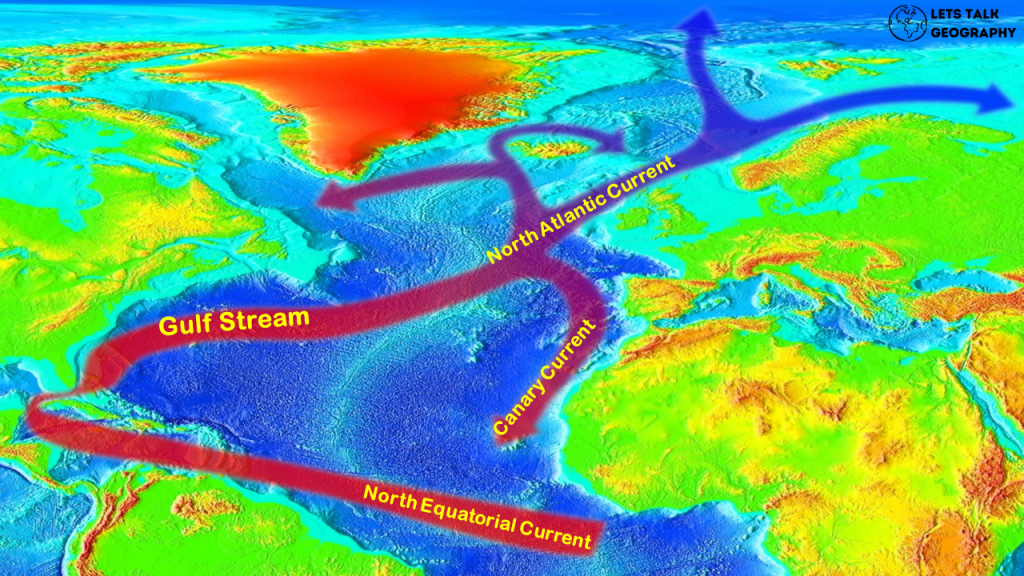The Gulf Stream is a warm current in the Atlantic Ocean that helps keep Europe temperate. Or is it a cold current? Some scientists say the Gulf Stream is keeping Europe colder than it would be otherwise. So what’s the truth about the Gulf Stream? And what does it mean for Europe’s climate? Stay tuned to find out! 😊

The importance of the different environmental aspects of nature has achieved great regard for a long time. In aligning with the current context, the concept of the Gulf Stream, the latter has been of vital importance in developing better notions in this field.
The discussions that would be presented to you guys in the following portions would enable you all to quench your thirst for knowledge and in this manner would engulf you to its extreme limits in this regard.
⫸ What is Gulf Stream?
The Gulf Stream which generally comprises the Northern extension of the North Atlantic Drift mainly is an ocean current that emerges from the Gulf of Mexico to Florida. The entire process occurs due to the emergence of an intensified current that enables the flow to move northwards towards the east coast of America.
This process further enables the Warm-Gulf Stream to split into two significant areas which comprise Northern Europe and the Southern Stream with the recirculation of the Canarian Current in the Eastern part.

Besides frequently changing its location, the Warm-Gulf Stream also influences the climatic conditions in the adjoining portions related to it. This has led to the emergence of the fact that the Northern part of Europe enjoys a warm winter while the others are focused on the colder aspect in this case.
The pivotal reason behind such an effect of the Gulf Stream is that of the working of the downwind that develops from the ocean leading to the produce a mild and warm effect hence the usage of the term Warm-Gulf Stream.
This entire system enables severe development of the cold cyclones in all regions at large which generates renewable energy to a great extent.
⫸ Speed of the Gulf Stream:
It has been denoted as the most significant current among all the others in general. From the above-mentioned analysis, the different manners of working of the Warm-Gulf Stream could be easily taken into consideration.
In this regard, it serves as the warm ocean current among all other oceans and moves at an average speed of “6.4 km per hour (four miles per hour)”.
The entire aspect depends on the concept that the speed of the Warm-Gulf Stream changes according to its location, in the sense that the speed is at its extreme while it locates itself near the surface and maintains the speed of 6.4 km per hour.
But the velocity of the speed changes according to its location. While locating itself in the North, the speed of the Stream slows down to about 1.6 km per hour.
This enables the Warm-Gulf Stream to provide greater advantages by supplying a huge amount of water incomparable to all other oceans in the world as well as generating renewable energy to a great extent.
These notions might help you guys to understand the entire notion without any haste.
⫸ Who discovered the Gulf Stream?
Before focusing on this issue, are you guys able to smell a kind of mystery and history in this case? If yes, then let’s engulf ourselves in the apparent history with which it has related itself.
The Stream was first charted by the notable Benjamin Franklin in the early years of the 1770s, during traveling in an American merchant ship. The area had been identified much earlier in the year 1513 by Ponce De Leon during their explorations through the heart of the Caribbean belt.
This identification led the person to specify the feeling that the wind fails to move forward but in the process moves backward and exhibits more power than the wind in general.
⫸ Is the Gulf Stream Warm or Cold?
This Stream has gone through significant research for a long time which has enabled the researchers and meteorologists to name the current as of the Thermohaline Circulation or Atlantic Meridional Overturning Circulation.
The major changes that are faced by the said ocean mainly occur due to the development of the conveyor belt with the help of the temperature and salt contained in general.
With its origin in the apex of Florida, the Gulf Stream remains warm and in the process develops swiftness in its flowing through the different areas of Canada and Northern Europe, leading the latter to enjoy a warm winter in general.
Though his analysis will help you guys to understand the type of current that the Stream would intend to supply it is quite distinct that the information could not quench your thirst.
So let’s delve into the aspect a bit more clearly:
- The flowing of the warm water from the equator leads it to cool which in this case leads to the concept of evaporation in the case which would lead the amount of salt content in the water to increase a considerable height.
- With the help of the low temperature and high salt content in the ocean, the current enables the water to sink in the oceans while maintaining a high density.
- This leads the water which is cold and dense to move slowly and eventually pulls itself back into the surface that occurs with the process of “upwelling” leading the circulation to complete its cycle.
- This change is the basis behind the frequent climate changes that occur in the contemporary world in general.
⫸ How did the Gulf Stream form?
After understanding the nature of the current associated with the Gulf Stream, it’s now time to fix our focus on the historic aspect of the current. This would in time make you guys understand the implications of the entire process associated with it.
The warm Gulf Stream had been first charted by notable mariner Benjamin Franklin and from then on the formation of the Warm-Gulf Stream could be taken into consideration.
The formation of the Gulf Stream can be cited in the following manner:
- The convergence occurs between the North Atlantic Equatorial Current which brings the tropical water from the East with the Florida Current bringing the warm water from the Gulf of Mexico.
- This enables the Gulf Stream to take the warm water and transport it towards the northern coast of the U.S.
- Being a western boundary current enables the Gulf Stream to provide a western intensification which makes the current narrow (50- 100 km wide), deep (to the depths of 1.5 km), and fast in its mode.
- While approaching Canada, the current changes its speed from fast to slow and leads to a formation of large rotating water masses known as rings or eddies.
- The warm-cold masses of the Gulf Stream form these rings which rotate counter-clockwise and move to the south which extends down to about 3.5 km deep and 500km wide.
- The warm-cold masses of the Gulf Stream form these rings which rotate counter-clockwise and move to the south which extends down to about 3.5 km deep and 500km wide.
⫸ Importance of the Gulf Stream
The Gulf Stream has shown several areas of development from its inception. While jotting down the areas of concern that have been discussed in the above-mentioned portions suggests that the Gulf Stream has been shown greater importance in the following areas:
It is important as it leads to the development of moderate temperature in the neighboring land areas.
- The density of water that the Warm-Gulf Stream mainly maintains enables a huge supply of water for the countries which otherwise could not be maintained by other oceans.
- The high force of the Warm-Gulf Stream enables the production of a huge amount of renewable energy in general which becomes one of the most significant areas of research in this regard.
⫸ Conclusion:
The time seems to fly as we come to the end of the entire discussion. The time has arrived when we need to return from our engulfing areas and justify our notions in this regard.
The entire discussion and the mysteries related to the entire event have been very well analyzed making the Gulf Stream or the Warm-Gulf Stream bestow their ultimate force on the working areas of the world to a great extent.
